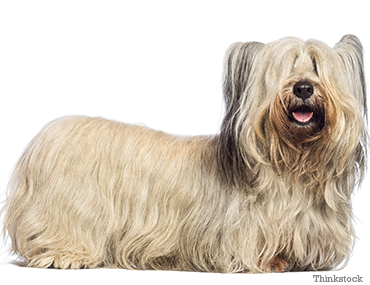Background
The Skye Terrier hails from Scotland’s Isle of Skye and dates back to the 16th century. Originally this breed was tasked to seek out and kill otters, foxes, and badgers that threatened farmer’s livestock. Their long coat was their shield and protected them from injury and inclement weather conditions.
During the 19th century, Queen Victoria, an avid dog lover, gained an interest in the breed while visiting Scotland and insisted that the dogs should be fashionable pets of noble ladies.
The Skye Terrier was recognized by the American Kennel Club in 1887.
Sizing up
- Weight: 35 to 45 lbs.
- Height: 9 to 10 inches
- Coat: Double coat with a short, soft undercoat and a hard, straight topcoat
- Color: Black, blue, cream, platinum, fawn, silver, or gray
- Life expectancy: 12 to 14 years
What’s the Skye Terrier like?
The Skye Terrier is like most other terriers: fearless and friendly towards people he knows but wary of strangers at first. He’s very intelligent and can pick up on certain vibes or emotions. When first meeting someone he will study them before deciding whether or not to let them pet him. Like most dogs he doesn’t like to be alone and is definitely not a backyard dog. Contrary to popular belief this little guy has great stamina and strength and loves to go on walks but will accompany you for a little R&R time on the couch. He has a mind of his own and may tend to wander away so keep an eye on him and start training immediately to avoid future problems.
Although the Skye Terrier’s double coat looks like it would be high maintenance it’s really not. No trimming is necessary and a weekly brushing should keep things in order. When bathing your furry friend it is recommended to squeeze or pull the shampoo through the coat so it flows easily in order to prevent breaking of the hairs on the coat.
Health
Skye Terrier’s can be affected by “Skye limp” or “puppy limp” which occurs in puppies between 3 and 10 months of age. They may also suffer from genetic forms of liver and kidney disease so it’s important to talk to the breeder about medical histories. Also watch for any of the following conditions:
- Glaucoma
- Lens luxation
- Hypothyroidism
- Von Willebrand’s disease (a blood clotting disorder)
- Ulcerative colitis
- Allergies
Takeaway Points
- The Skye Terrier is a cheerful dog that would be suitable for any family.
- The Skye Terrier is very independent so you may want to keep an eye on him when let loose outside.
- The Skye Terrier does shed moderately so if you have allergies this breed could increase them.
- If left alone for too long the Skye Terrier may start to become destructive, training can prevent this behavior or you could try to limit your time away from him.
If you have any questions or concerns, you should always visit or call your veterinarian -- they are your best resource to ensure the health and well-being of your pets.
